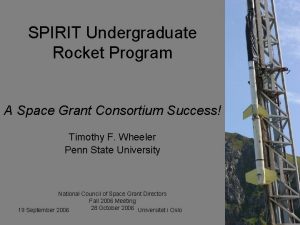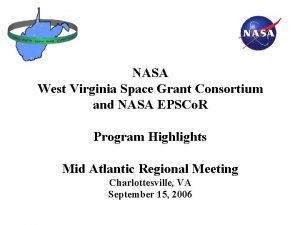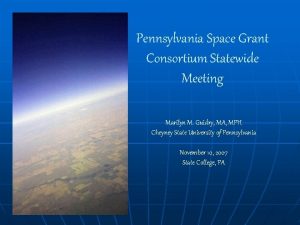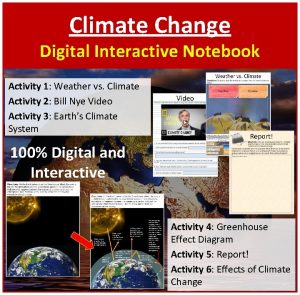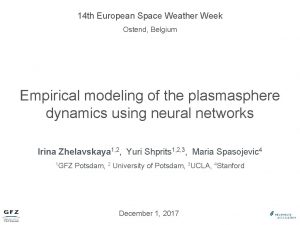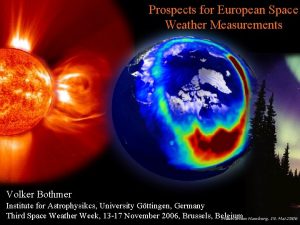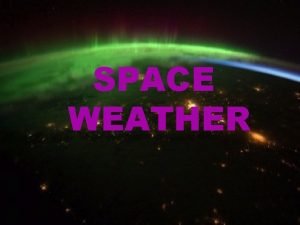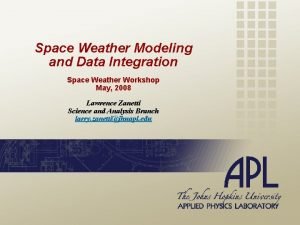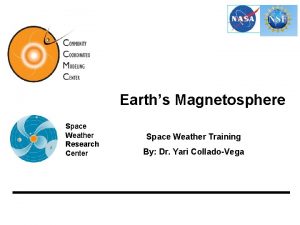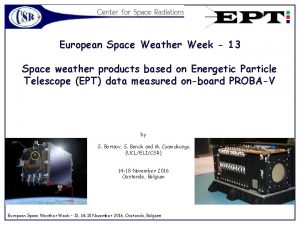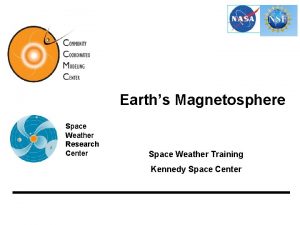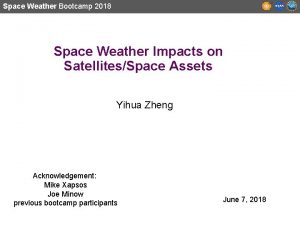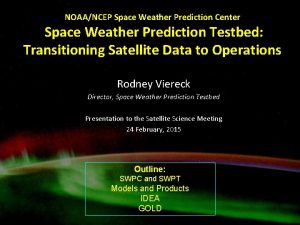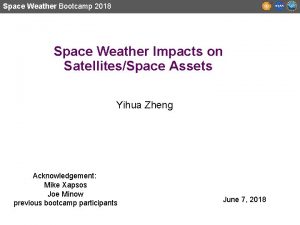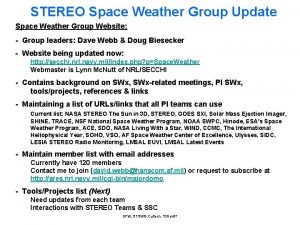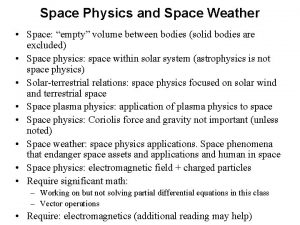Space Weather Activities at NSSTC Oklahoma Space Grant



























- Slides: 27

Space Weather Activities at NSSTC Oklahoma Space Grant Tour Dr. David H. Hathaway NASA/MSFC/NSSTC 2007 March 23

Space Weather Space weather refers to conditions on the Sun and in the space environment that can influence the performance and reliability of space-borne and groundbased technological systems, and can endanger human life or health. Sources of Space Weather 1. Photons (X-rays, EUV) 2. Energetic Particles (Protons) 3. Magnetized Plasma

Example: The Bastille Day Event The flare, seen in EUV, emits energetic photons and accelerates particles. The coronal mass ejection, also accelerates particles and ejects magnetized plasma from the Sun. The energetic particles shower the imaging instruments on SOHO minutes later.

Space Weather Effects

Effects of Solar Activity: On Human Space Flight Shuttle missions and EVAs require particular attention. The Space Radiation Analysis Group (SRAG) reports to Mission Control when: K-index > 6, X-Ray Flux > M 5, Protons at >100 Me. V > 50. ISS: 50 pfu at > 100 Me. V - shutdown the robotic arm 100 pfu at > 100 Me. V - alert Mission Control. The Flight Team will start to evaluate a plan to shutdown equipment to prevent damage. 200 pfu at > 100 Me. V - plan is implemented

Effects of Solar Activity: On Satellites Radiation (protons, electrons, alpha particles) from solar flares and coronal mass ejections can damage electronics on satellites. Heating of the Earth’s upper atmosphere increases satellite drag. • 1991 GOES • 1995 Deutsche Telekom • 1996 Telesat Canada • 1997 Telstar 401 • 2000/07/14 ASCA • 2003 Mars Odyssey • 4500 spacecraft anomalies over last 25 years

Effects of Solar Activity: On Power Grids Solar disturbances shake the Earth’s magnetic field. This sets up huge electrical currents in power lines and pipe lines. The solar storm of March 13 th 1989 fried a $10 M transformer in NJ. The same storm interrupted power to the province of Quebec for 6 days.

Effects of Solar Activity: On Airline Operations HF Communication only • Polar flights departing from North America use VHF (30 -300 MHz) comm or Satcom with Canadian ATCs and Arctic Radio. • Flights rely on HF (3 – 30 MHz) communication inside the 82 degree circle. • Growth: Airlines operating China-US routes goes from 4 to 6 and then number of weekly flights goes from 54 to 249 over the next 6 -years.

Effects of Solar Activity: On Climate? Yearly Sunspot Numbers and Reconstructed Northern Hemisphere Temperature (Mann, Bradley & Hughes Nature 392, 779787, 1998) smoothed with an 11 -year FWHM tapered Gaussian and trimmed to valid smoothed data. The correlation coefficient from the overlapping period is 0. 78 but the physical mechanism linking the two is unknown.

The Solar Sources of Space Weather

The “ 11 -year” Sunspot Cycle The sunspot cycle was discovered by Heinrich Schwabe in 1844 from 18 -years of personal observations. The cycle periods are normally distributed about 131 months with a variance of 14 months.

Sunspot Number and Solar Activity Sunspot number is well correlated with other indicators of solar activity. The long record of sunspot numbers helps to better characterize the solar cycle. Predicting the sunspot number also provides an estimate of these other source of solar activity. Sunspot Area Total Irradiance 10. 7 cm Radio Flux GOES X-Ray Flares Geomagnetic aa index Climax Cosmic-Ray Flux

Magnetic Fields are Behind all Solar Activity

The Sun’s Magnetic Cycle • The high conductivity of the fluid within the Sun makes the magnetic field and the fluid flow together (frozen in field lines). • The high pressures found inside the Sun insures that the fluid flow controls the magnetic field (except in the centers of sunspots).

Dynamos with Meridional Flow Recent Dynamo models incorporate a deep meridional flow to transport magnetic flux toward the equator at the base of the convection zone. These models explain the equatorward drift of activity, the poleward drift of weak magnetic elements on the surface, the length of the cycle from the speed of the flow, and give a relationship between polar fields at minimum and the amplitude of future cycles. Dikpati and Charbonneau, Ap. J 518, 508 -520, 1999

The Dynamo Prediction Dikpati, de Toma & Gilman (2006) have fed positions into their numerical model for the reproduced the amplitudes of the last unprecedented accuracy (RMS error < 10). sunspot areas and Sun’s dynamo and eight cycles with Cycle 24 Prediction ~ 165 ± 15

Magnetic Field and Solar Flares are likely to occur when the magnetic field along the neutral line between opposite polarity regions is sheared or twisted from the direction given by the potential field. Vector Magnetograms are needed to determine the presence of this magnetic shear.

Correlations with CMEs Red + => CME Blue + => no CME

Magnetic Models for CMEs

Current Missions Ulysses (ESA/NASA – 1990) SOHO (ESA/NASA – 1995) TRACE (NASA – 1998) RHESSI (NASA – 2002) STEREO (NASA -2006/08) Hinode (Japan/US/UK – 2006/09)

Future Missions Solar Dynamics Observatory (NASA -2008/08) Solar Sentinels (NASA/ESA? -2012? )

The Earth’s Response to Space Weather

Coronal Mass Ejections Interact with the Earth’s Magnetosphere

Magnetic Models for Geomagnetic Activity

Ground-Level Response

A Space Weather-observing “constellation” of satellites

Conclusions • Space Weather must be understood and reliably predicted for safe and successful space exploration • Additional scientific research is needed to do this http: //solarscience. msfc. nasa. gov/
 Grant oklahoma weather
Grant oklahoma weather Oklahoma tuition aid grant
Oklahoma tuition aid grant Dr linda mason
Dr linda mason New jersey space grant consortium
New jersey space grant consortium Wisconsin space grant consortium
Wisconsin space grant consortium Wisconsin space grant consortium
Wisconsin space grant consortium Pa space grant
Pa space grant New jersey space grant consortium
New jersey space grant consortium Operating activities vs investing activities
Operating activities vs investing activities It is a popular indoor and outdoor sport
It is a popular indoor and outdoor sport Support activities and primary activities
Support activities and primary activities Primary activities and tertiary activities
Primary activities and tertiary activities Weather and climate interactive activities
Weather and climate interactive activities Station model symbols
Station model symbols Whether the weather poem
Whether the weather poem Poem about weather and climate
Poem about weather and climate Its windy gif
Its windy gif Weather and whether
Weather and whether Heavy weather by weather report
Heavy weather by weather report Capital weather gang weather wall
Capital weather gang weather wall Eyfs space activities
Eyfs space activities Space weather family guy
Space weather family guy European space weather week
European space weather week Space weather
Space weather Which major river separates texas from mexico
Which major river separates texas from mexico Oklahoma pace program
Oklahoma pace program Insure oklahoma qualifications
Insure oklahoma qualifications Oklahoma supplemental online course program
Oklahoma supplemental online course program




